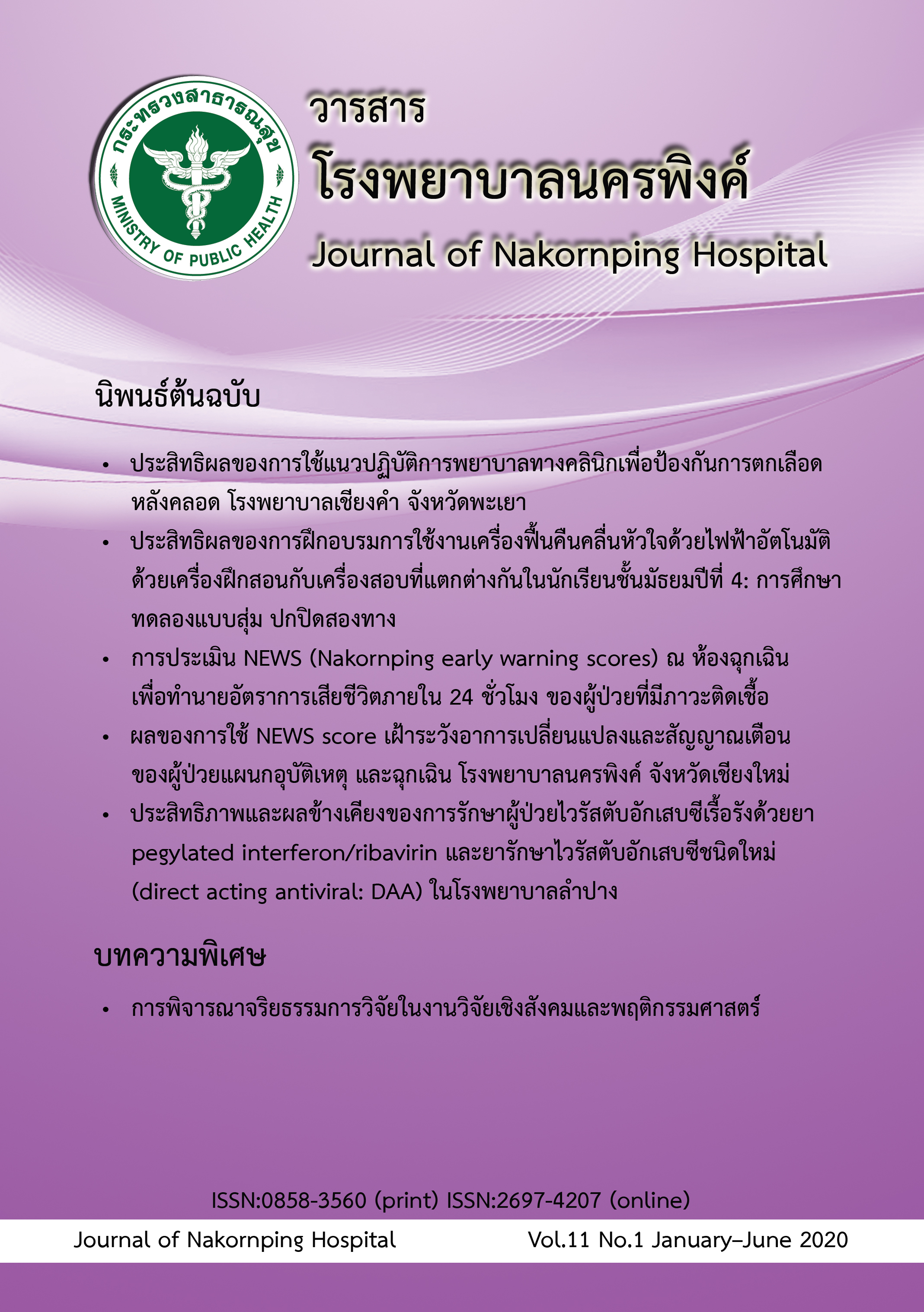Effectiveness of Automated External Defibrillator training using different Automated External Defibrillator models in teaching and assessment in 10th Grade Students: A Randomized Controlled, Double-Blinded Trial
Keywords:
AED, AED training, Basic life support, CPRAbstract
Non-healthcare providers are allowed to use AEDs without prior training. Despite this, recent study showed that approximately 20% of schoolchildren without prior training are able to use an AED correctly.
Primary objective was to study the effectiveness of AED training using different models of AEDs in teaching and assessment.
Method: This study, a randomized control trial, double-blinded was conducted on 10th grade students in Chiang Mai province. Participants were randomly allocated into two groups: forty students were enrolled into the first group, where different AED models were used; 40 students were enrolled into the second group, where the same AED models were used for teaching and assessment sessions. Teaching sessions were provided by BLS instructors, and assessment sessions immediately followed the teaching sessions. Study end point was pass or fail, and time to first shock. Statistical analysis was performed using Exact probability test and Mann-Whitney U Test.
Results: Eighty 10th grade students in Chiang Mai province were enrolled into the study. The mean age of the first group was 15.570.50 years, and 15.650.48 years for the second group. Age, sex, average GPA grades, previous BLS knowledge, and AED models used were not statistically different. Thirty-five students (87.50%) and 36 students (90.0%) passed the practical assessment in the first and second groups, respectively. Time to first shock was 50 seconds (iqr 20.7) and 46.5 seconds (iqr 16.2) in the first and second groups, respectively (p-value= 0.447).
Conclusion: AED training by using different AED models in the teaching and assessment models does not yield a significant difference in correct AED usage nor time to first shock.
References
The Heart Association of Thailand under the Royal Patronage H.M. The King. Thai Resuscitation Council. Guideline: Basic Life Support and Automatic External Defibrillators (AED) for Lay person 2017. 3rd edition. Bangkok: Punyamit Printing; 2017.
American Heart Association. 2015 American Heart Association Guidelines Update for Cardiopulmonary Resuscitation and Emergency Cardiovascular Care. Circulation 2015;132: S315-573.
American Heart Association. Basic Life Support Provider manual. Channing L Bete Co Inc. 1 edition (February 1, 2016), USA. American Heart Association,2016.
Weisfeldt M, Sitlani C, Ornato J, Rea T, Aufderheide T, Davis D, et al. Survival After Application of Automatic External Defibrillators Before Arrival of the Emergency Medical System. Evaluation in the Resuscitation Outcomes Consortium Population of 21 Million. Journal of the American College of Cardiology. (2010) 55(16) 1713-1720
Government Gazette. Announce of Board of Emergengy Medicine. Define the use of Automatic External Defibrillators as a first aid. Vol 132 special part 108 e. Thailand Government Gazette. 2015. p11.
Bhanji F, Donoghue AJ, Wolff MS, Flores GE, Halamek LP, Berman JM, et al. Part 14: Education: 2015 American Heart Association Guidelines Update for Cardiopulmonary Resuscitation and Emergency Cardiovascular Care. Circulation. 2015 Nov 3;132(18 Suppl 2):S561-73.
Yeung J, Okamoto D, Soar J, Perkins GD. AED training and its impact on skill acquisition, retention and performance--a systematic review of alternative training methods. Resuscitation. 2011 Jun;82(6):657-64.
Meischke HW, Rea T, Eisenberg MS, Schaeffer SM, Kudenchuk P. Training seniors in the operation of an automated external defibrillator: a randomized trial comparing two training methods. Ann Emerg Med. September 2001; 38:216-222.
Rodríguez-Núñez A, Jorge-Soto C, Abelairas-Gómez C, Barcala-Furelos R, Garrido-Viñas A, Navarro-Patón R, et al. Automated external defibrillation skills by naive schoolchildren. Resuscitation. 2016 Sep; 106:37-41.
Tjørnhøj-Thomsen T, Zinckernagel L, Hansen CM, Rod MH, Folke F, Torp-Pedersen C.
A qualitative study to identify barriers to deployment and student training in the use of automated external defibrillators in schools. BMC Emerg Med. 2016;17(1):3.
American Heart Association. Basic Life Support instructor manual. USA. American Heart Association (1726), 2016.
Nina Plant, Katherine Taylor. How best to teach CPR to schoolchildren: A systematic review. Resuscitation. 2013; (84)415– 421.
Younas S, Raynes A, Morton S, Mackway-Jones K. An evaluation of the effectiveness of the Opportunities for Resuscitation and Citizen Safety (ORCS) defibrillator training programme designed for older school children. Resuscitation. 2006;71(2):222–8.
American Heart Association. ECC guideline. Part 4: The Automated External Defibrillator Circulation. 2000; 102(suppl1): I60-I76.
Downloads
Published
How to Cite
Issue
Section
License
The articles that had been published in the journal is copyright of Journal of Nakornping hospital, Chiang Mai.
Contents and comments in the articles in Journal of Nakornping hospital are at owner’s responsibilities that editor team may not totally agree with.



